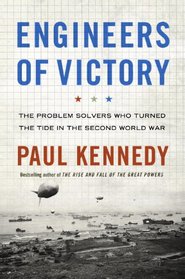It's hard to know what to write about this book except that it was a fantastic read. It reminds me of Paul Harvey's "The Rest of the Story."
A quote in the book basically states you can have everything you need, but it you don't apply those resources intelligently, then they are wasted.
In some ways the writes a revisionist history of World War II, in other ways, he's telling you what really happened "behind the scenes" which allowed the Allies to win the war.
The Russian T-34 tank was junk, the American P-51 fighter was a waste of resources and the Army was going to cancel it; bombing German cities was a better use of bombers then protecting convoys..... the list just goes on.
All of the above were proven false and the war was won because someone took the time and trouble to solve the problems that plagued the above. This is just a small part of what the author covers.
If you are interested in the mechanics of how the war was won which aren't covered in most books, then you really MUST read this one. I can't recommend it too highly.
One of my favorites is the paper-mache wing tanks which some genius came up with. These extended the range of the fighters protecting the bombers and help destroy the German air force. And when the wing tanks were dropped over enemy territory, there were useless to the enemy. Whereas, if they had been made of aluminum they would have provided an essential war material to the Germans.
Read this book!
A quote in the book basically states you can have everything you need, but it you don't apply those resources intelligently, then they are wasted.
In some ways the writes a revisionist history of World War II, in other ways, he's telling you what really happened "behind the scenes" which allowed the Allies to win the war.
The Russian T-34 tank was junk, the American P-51 fighter was a waste of resources and the Army was going to cancel it; bombing German cities was a better use of bombers then protecting convoys..... the list just goes on.
All of the above were proven false and the war was won because someone took the time and trouble to solve the problems that plagued the above. This is just a small part of what the author covers.
If you are interested in the mechanics of how the war was won which aren't covered in most books, then you really MUST read this one. I can't recommend it too highly.
One of my favorites is the paper-mache wing tanks which some genius came up with. These extended the range of the fighters protecting the bombers and help destroy the German air force. And when the wing tanks were dropped over enemy territory, there were useless to the enemy. Whereas, if they had been made of aluminum they would have provided an essential war material to the Germans.
Read this book!




